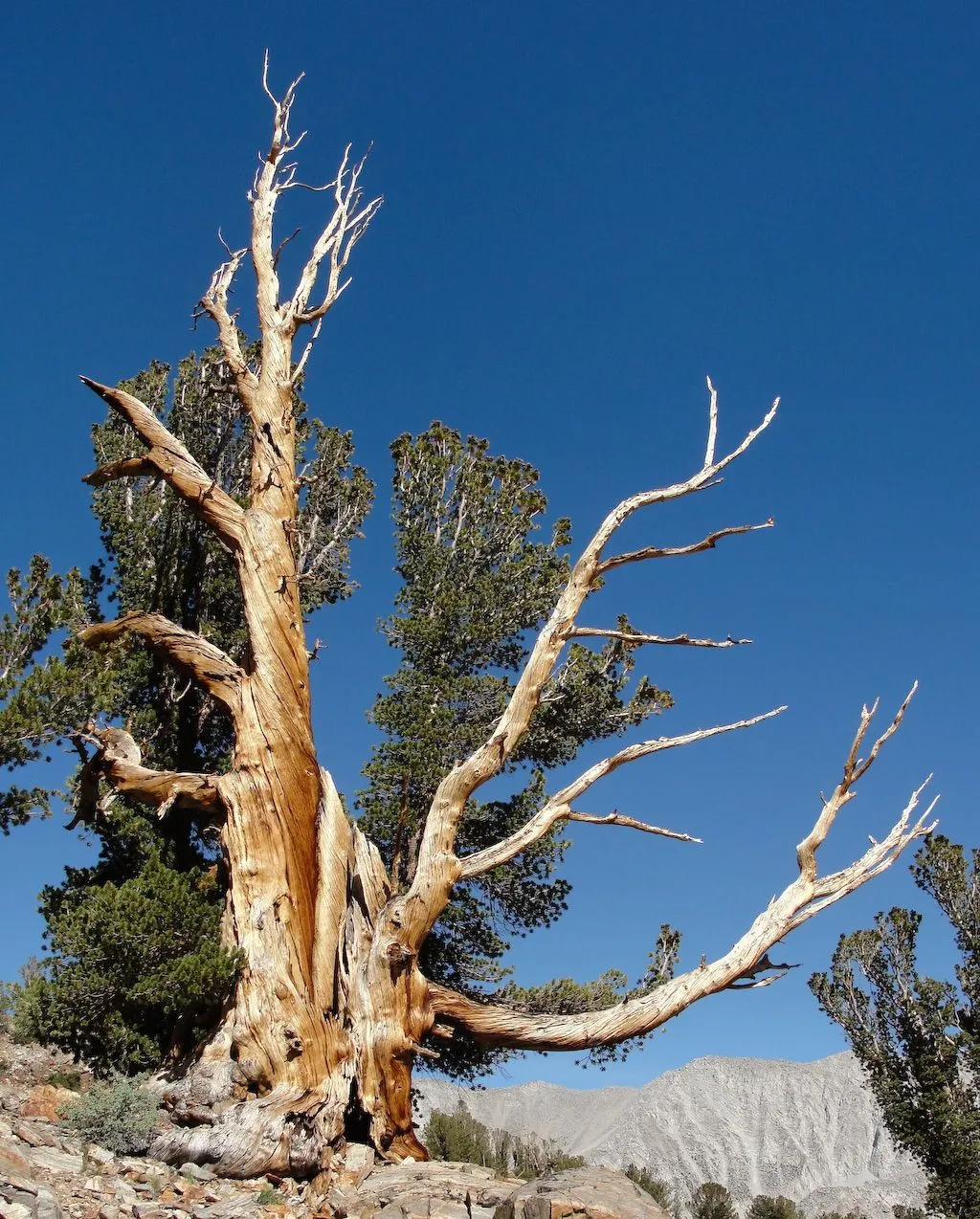
Author: Engelm.
Bibliography: Trans. Acad. Sci. St. Louis 2: 209 (1863)
Year: 1863
Status: accepted
Rank: species
Genus: Pinus
Vegetable: False
Observations: W. Canada to W. U.S.A.
The Alpine whitebark pine, scientifically known as Pinus albicaulis, is a fascinating and resilient species native to the mountainous regions of Western Canada and the Western United States. This remarkable pine belongs to the Pinaceae family, a diverse group of coniferous trees that thrive in various climates across the globe.
First described in 1863, the Alpine whitebark pine has since become an essential component of high-altitude ecosystems, particularly in the Rocky Mountains, the Sierra Nevada, and the Cascades. The tree is well adapted to harsh alpine environments where it faces extreme weather conditions, including strong winds, heavy snowfall, and short growing seasons.
Characterized by its sturdy, often gnarled form, the Alpine whitebark pine is typically found at elevations ranging from 1,800 to 3,700 meters. It can frequently be seen growing on rocky outcrops and exposed ridges where few other tree species can survive. The tree’s unique appearance, with its white bark and twisted, windswept silhouette, has made it a symbol of endurance and resilience.
Pinus albicaulis plays a crucial ecological role in its native habitat. Its seeds serve as a vital food source for various wildlife species, including the Clark’s nutcracker, which plays an integral role in the tree’s reproduction. The nutcracker caches the seeds in the ground, many of which are not retrieved, giving rise to new trees. The symbiotic relationship between the Alpine whitebark pine and the Clark’s nutcracker exemplifies the intricate connections within these ecosystems.
Conservation efforts are increasingly important for this species, as it faces threats from climate change, habitat loss, and invasive diseases such as white pine blister rust. Preservation initiatives aim to protect and restore populations of the Alpine whitebark pine, ensuring that this stellar example of nature’s fortitude continues to grace the high-elevation landscapes of North America for centuries to come.
In summary, the Alpine whitebark pine (Pinus albicaulis) is a robust and vital tree species endemic to the high mountains of Western North America. Its presence is crucial for maintaining the delicate ecological balance of alpine environments, symbolizing both the fragility and resilience of nature’s wondrous design.
Hun: amerikai cirbolya
Eng: scrub pine, whitebark pine, alpine whitebark pine, white pine
Deu: weißstämmige zirbelkiefer, weißstämmige kiefer
Fra: pin albicaule, pin blanc, pin à écorce blanche, pin à blanche écorce
Ita: pino a corbeccia bianco, pino albicaule
En: Alpine whitebark pine, Whitebark pine, Alpine white pine, Dwarf pine, Scrub Pine, White-bark pine, White pine
Ar: صنوبر أبيض الساق
Ca: Pi d’escorça blanca
Zh: 美国白皮松
Hr: Bjelokori bor
Cs: Borovice bělokmenná
Et: Valgetüveline seedermänd
Fi: Valkorunkosembra
Fr: Pine à blanche écorce, Pin albicaule, Pin blanc, Pin à écorce blanche, Pin à blanche écorce
De: Weißstämmige Kiefer, Weißstämmige Zirbelkiefer
He: אורן לבן-קליפה
Hu: Fehértörzsű fenyő, Amerikai cirbolya
Is: Klettafura
It: Pino albicaule, Pino a corbeccia bianco
Lt: Baltakamienė pušis
Fa: کاج ساقسفید
Ru: Сосна белокорая
Zh-hant: 美國白皮松
Uk: Сосна білокора
Vi: Thông vỏ trắng Bắc Mỹ
Taken Jan 1, 1900 by EOL − Niehaus, T.F. (cc-by-nc-sa)
Taken Feb 18, 2001 by EOL − Robert Potts (cc-by-nc-sa)
Taken Feb 18, 2001 by EOL − Robert Potts (cc-by-nc-sa)
Taken May 6, 2014 by EOL − Gerald and Buff Corsi (cc-by-nc-sa)
Taken Sep 6, 2009 by EOL − Miguel Vieira (cc-by)
Taken Feb 6, 2010 by EOL − Keir Morse (cc-by-nc-sa)
Taken Jul 14, 2007 by EOL − Steven J. Baskauf (cc-by-nc-sa)
Taken Jul 14, 2007 by EOL − Steven J. Baskauf (cc-by-nc-sa)
Taken Feb 18, 2001 by EOL − Robert Potts (cc-by-nc-sa)
Taken Dec 27, 2020 by Catalin Gruia (cc-by-sa)
Taken Jun 7, 2000 by EOL − Charles Webber (cc-by-nc-sa)
Taken Jan 1, 1900 by EOL − Niehaus, T.F. (cc-by-nc-sa)
Taken May 6, 2014 by EOL − Gerald and Buff Corsi (cc-by-nc-sa)
Taken Dec 22, 2015 by EOL − Gerald and Buff Corsi (cc-by-nc-sa)
Taken Feb 6, 2010 by EOL − Keir Morse (cc-by-nc-sa)
Taken Jul 14, 2007 by EOL − Steven J. Baskauf (cc-by-nc-sa)
Taken Jan 1, 1900 by EOL − Niehaus, T.F. (cc-by-nc-sa)
Taken Jun 10, 2020 by Paul Brown (cc-by-sa)
Taken Dec 27, 2020 by Catalin Gruia (cc-by-sa)
Taken Feb 26, 2022 by Danny Kozicki (cc-by-sa)
Taken Feb 6, 2010 by EOL − Keir Morse (cc-by-nc-sa)
Taken Jan 1, 1900 by EOL − Walter Siegmund (cc-by-sa)
Taken Jan 1, 1900 by EOL − Walter Siegmund (cc-by-sa)
Taken Oct 25, 2015 by EOL − Barry Breckling (cc-by-nc-sa)
Growth form>: Single Stem
Growth habit>: Tree
Growth rate>: Slow
Ph maximum: 8.0
Ph minimum: 4.8
Family: Myrtaceae Author: (F.Muell.) K.D.Hill & L.A.S.Johnson Bibliography: Telopea 6: 402 (1995) Year: 1995 Status:…
Family: Rubiaceae Author: Pierre ex A.Froehner Bibliography: Notizbl. Bot. Gart. Berlin-Dahlem 1: 237 (1897) Year:…
Family: Sapindaceae Author: Koidz. Bibliography: J. Coll. Sci. Imp. Univ. Tokyo 32(1): 38 (1911) Year:…
Family: Asteraceae Author: A.Gray Bibliography: Pacif. Railr. Rep.: 107 (1857) Year: 1857 Status: accepted Rank:…
Family: Fabaceae Author: Medik. Bibliography: Vorles. Churpfälz. Phys.-Ökon. Ges. 2: 398 (1787) Year: 1787 Status:…
Family: Aspleniaceae Author: (Cav.) Alston Bibliography: Bull. Misc. Inform. Kew 1932: 309 (1932) Year: 1932…